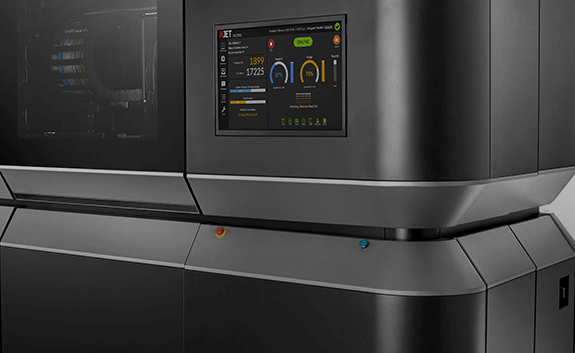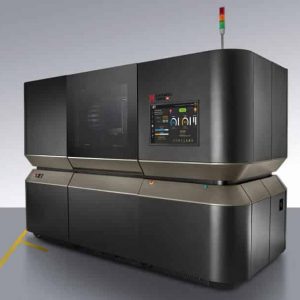|
Carmel 1400 M is an industrial metal 3D printer produced by XJet – a printer manufacturer based in Israel. It is an industrial 3D printer series that utilizes patented NanoParticle Jetting technology for 3D printing with metal materials.
Under this 3D printer system, complex metal, as well as ceramic parts, can be produced using a unique liquid dispersion methodology. 1400 M is specifically meant for metal part production whereas 1400 C is typically for ceramic parts.
Under this technology, printing with high melting temperature materials such as Alumina is also possible. Herein the material is broken into nanoparticles which can then be mixed with a special XJet liquid.
The inkjet nozzles then jet the metal material after which the printer heats up to 300 degrees Celsius, then the liquid evaporates leaving only the metal particles.
So, let’s know more about XJet Carmel 1400 M by looking in-depth at its various facets.
Features
The leading role in the production of fine quality metal parts is done by thousands of nozzles depositing fine layers of metal liquid and easily removing support material.
Such construction allows users to print complex geometries layer after the other. Because of this, 3D printing dimensionally accurate parts and functional prototypes is easily possible.
Many subtle features of Carmel 1400 M let it function in the way it does. Some of those features are mentioned and explained below. Excited? Let’s get started.
Large Touchscreen Interface
To let its users gain complete control over all the functions of Carmel 1400 M, XJet has put in place a large touchscreen interface.
Using the interface, operators can control and change different basic settings that affect the overall print quality and speed at which part is about to be printed.
Additionally, users can also make changes in the design aspect of the part, based on which the final geometry of the part will come into being.
Moreover, part loading and its deposition over the print bed which is the most important aspect of Nanoparticle jetting 3D printing technology can be done using the touchscreen.
So, overall a lot of the aspects that affect the final part quality can be controlled, as well as modified using this feature. Apart from that, the basic start, pause, and stop of prints can be done with a single click on the touchscreen.
Design Freedom
Nanoparticle jetting 3D printing technology starts with a unique liquid dispersion methodology. Herein Liquid suspensions containing solid nanoparticles of selected build and support materials are jetted onto the build tray for additively manufacturing detailed parts.
Then, these liquid suspensions serve as the base materials for the printing process, unlike most metal 3D printing technologies that take into account hazardous and hard-to-handle powders. XJet’s liquid suspensions are supplied and installed in hassle-free cartridges.
Such a technology’s ultrathin layers which are composed of nanoparticles empower virtually unlimited design flexibility for printing parts with complex geometries, fine details, nearest net shapes, and smooth surfaces.
No material wastes
The material calculating system of Carmel 1400 M is very unique. Its integration with the printer’s software is what makes the complete calculation precise.
Also, the printer manufacturer has ensured that the entire system has to undergo a workflow that’s based on a very low level of tolerance. All of this makes Carmel 1400 M a very accurate machine.
The printer manufacturer guarantees that there’d be no waste from the material that the machines ask to be utilized during the printing process.
Note that, Carmel 1400 M prints using metal material which is a lot more expensive than thermoplastic filaments or photopolymer resins. So, in a way, this feature of the printer saves its users money.
Rapid Printing Speed
XJet claims that its patented Nano jetting 3D printing technology is at least 5 times faster than other metal 3D printing technologies.
This means that for printing a metal part with a DMLS 3D printer if it takes two days, printing the same part using Carmel 1400 M would take around nine hours.
This feature makes the printer a manufacturer-friendly 3D printer that lets owners complete their printing projects on time.
Also, it helps while fulfilling continuous manufacturing projects in a very optimal way. Especially mass customization which is not something that you can expect from every printer to deliver can be made possible using Carmel 1400 M.
User-friendly Software
Carmel 1400 M comes compatible with Autodesk Netfabb Standard software which is a highly efficient application, especially for metal prototyping.
It lets users make advanced-level changes in designs and allows them to manage micro-level material deposition, sintering as well as even cooling. It is adept and highly effective in all areas of nanoparticle jetting 3D printing technology.
Starting from the very basic cartridge loading, to material jetting, followed by support removal, and lastly undergoing final sintering.
The application lets users manage all the aspects very minutely thereby leading to the production of parts and functional prototypes with amazing geometries, curves, and edges. Whether it’s a small or a big geometry, the printing system can provide dimensional accuracy like no other.
Specifications
 Credit: xjet3d.com
Credit: xjet3d.com
XJet Carmel 1400 M features a build tray of dimensions 500 mm * 280 mm. It can print objects of height 200 mm. The complete printing system can be controlled via a mobile application.
The printer has a heat dissipation rate of 3 Kilowatts i.e. 10240 BTU per hour. It requires an air pressure of 6 bars.
Price
To get the exact price of XJet Carmel 1400 M one needs to request a quote from XJet.
First Impression

Carmel 1400 M has a dimension of 3100 mm * 1850 mm * 2120 mm and weighs 3000 kilograms. It has a robust build-up, just like that of most other industrial 3D printers.
The middle compartment of the printing system is transparent thereby giving users a peek into the 3D printing process happening inside. Besides it, there is this huge touch screen interface from where you’d be able to control most functions on the printer.
Setup
Being a professional-grade 3D printer, Carmel 1400 M comes with on-site assistance that guides you through the complete printing system.
As NPJ 3D printing technology is executed in four different parts, it is important to know about the micro-level of control that you get as a user and after that, manufacturing some test prints before finally getting to 3D printing parts and functional prototypes is a decent way to go about the printer.
However, doing all of that shouldn’t take much time if you have basic exposure to powder bed fusion 3D printing technology.
Print Type/Cost
Nanoparticle jetting 3D printing technology takes place in four different parts i.e.
- Cartridge loading: Solid nanoparticles are delivered in a liquid suspension within conveniently sealed cartridges.
- Material jetting: Printheads with thousands of inkjet nozzles jet millions of ultrafine drops of both build and support materials onto the system build tray in ultrathin layers at the same time.
- Support material: After the part is manufactured the support structure disintegrates and delivers the final print geometry.
- Final Sintering: Produced parts undergo a simple and relatively short overnight sintering process thereby decreasing the overall print times.
The cost of 3D printing a part via Nanoparticle jetting 3D printing technology is a little on the higher end for a simple reason i.e. the cost depends on many factors such as the part geometry, the material needed for making that part and its cost, the support structures needed for making that part, the sintering source, etc.
Print Quality
 Credit: 3dprintingindustry.com
Credit: 3dprintingindustry.com
Nanoparticle jetting 3D printing technology features stochastic nanoparticles, ultrathin layers, and simultaneous jetting delivering fine detailing even on complex 3D prints.
According to the printer manufacturer, parts with 99.9 percent density, isotropic uniformity, and extremely low shrinkage can be made using the printing system.
Software
The printer manufacturer recommends Autodesk Netfabb 3D printing software and Ultimate. Both of them are professional-grade 3D printing applications that enable their users to make advanced-level settings using their interface.
They straightforwardly permit the operator to do in-depth and generate support automatically, provide easy support removal, and allow for a smooth workflow during all four parts of NPJ 3D printing technology.
Customer Support
XJet offers onsite technical assistance manually as well as digitally via a video call. Apart from that the usual emails and on-call troubleshooting are undertaken by the company’s technical team easily.
Parameters Influencing Buying Decision
Below are the chief points about Carmel 1400 M.
3D Printer Cost: Users need to request a quote from XJet to know Carmel 1400 M’s exact price.
3D Print Speed: Compared to other metal 3D printing methods, Nanoparticle jetting 3D printing technology is claimed to produce parts and functional prototypes five times faster. It is important to note that the printing system can do so without compromising on quality.
3D Print Quality: Extremely detailed 3D printed metal geometries can be manufactured on Carmel 1400 M. Thanks to the technology employed for 3D printing – Nanoparticle jetting 3D printing technology, a unique liquid dispersion methodology that allows building metal parts and functional prototypes with 99.9 percent density, isotropic uniformity, and extremely low shrinkage.
3D Printer Capability: Carmel 1400 C is capable of unrivaled quality, accuracy, and repeatability. The system enables easy and safe production of high-density metal parts for wide-ranging applications and industries. It features one of the industry’s largest build trays enabling simultaneous production of multiple identical or different metal parts at zero cost of geometric complexity.
3D Printer Practicality: The printing system produces parts with the help of support structures made from soluble materials which easily dissolve and reduce labor involvement resulting in a decrease in the need for time consumption as well as costly post-processing.
3D Printer User Expectations: XJet Carmel 1400 M demands a huge one-time investment that cannot be affordable to anyone. Only large-scale metal part manufacturers can afford such a machine. It can manufacture high-quality parts in optimal time using its patented and unique Nanoparticle jetting technology. The system lets users gain micro-control over various aspects of the 3D printing process that were not possible to have before.
The Verdict
XJet Carmel 1400 M is based on revolutionary nanoparticle jetting 3D printing technology. It enables the production of metal additive manufacturing on one of the largest build trays ever built in the world.
Metal parts and functional prototypes of the highest quality, featuring an unprecedented level of detail, finish as well as accuracy without any compromise on throughput and build time is possible.
Understanding the complete 3D printing process and workflow might take more time than understanding DMLS or other powder bed fusion 3D printing technologies, but once done, Nanoparticle jetting can let users achieve more than the formerly mentioned technologies.
The level of accuracy and finishes generated on parts using NPJ 3D printing technology delivers physical, geometric, and operational advantages.
So, for all the metal part manufacturers, XJet Carmel 1400 M is a very reliable option to build huge scale metal objects need for various applications. Not only does the printing system build highly functional metal parts with intricate geometries, but also it does so in a commendable print time.









